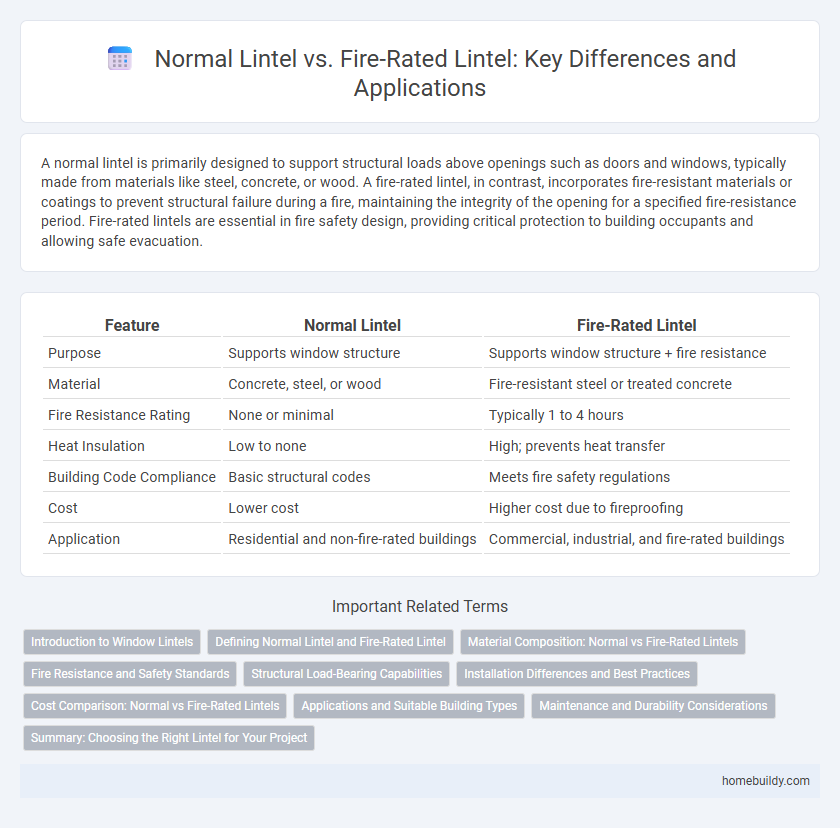A normal lintel is primarily designed to support structural loads above openings such as doors and windows, typically made from materials like steel, concrete, or wood. A fire-rated lintel, in contrast, incorporates fire-resistant materials or coatings to prevent structural failure during a fire, maintaining the integrity of the opening for a specified fire-resistance period. Fire-rated lintels are essential in fire safety design, providing critical protection to building occupants and allowing safe evacuation.
Table of Comparison
| Feature | Normal Lintel | Fire-Rated Lintel |
|---|---|---|
| Purpose | Supports window structure | Supports window structure + fire resistance |
| Material | Concrete, steel, or wood | Fire-resistant steel or treated concrete |
| Fire Resistance Rating | None or minimal | Typically 1 to 4 hours |
| Heat Insulation | Low to none | High; prevents heat transfer |
| Building Code Compliance | Basic structural codes | Meets fire safety regulations |
| Cost | Lower cost | Higher cost due to fireproofing |
| Application | Residential and non-fire-rated buildings | Commercial, industrial, and fire-rated buildings |
Introduction to Window Lintels
Window lintels are horizontal structural elements placed above openings to support the weight of the wall above. Normal lintels are typically made from materials like reinforced concrete, steel, or stone and provide standard load-bearing capacity. Fire-rated lintels incorporate fire-resistant materials or coatings designed to maintain structural integrity and prevent heat transfer during fire exposure, enhancing building safety.
Defining Normal Lintel and Fire-Rated Lintel
A normal lintel is a horizontal support element above a window or door opening, typically constructed from materials like reinforced concrete, steel, or timber, designed to bear structural loads without specific fire resistance requirements. A fire-rated lintel, however, incorporates fire-resistant materials or coatings to maintain structural integrity and prevent collapse during exposure to high temperatures, complying with fire safety standards such as ASTM E119 or UL 263. The primary distinction lies in fire performance, with fire-rated lintels enhancing building safety by slowing fire spread in critical openings.
Material Composition: Normal vs Fire-Rated Lintels
Normal window lintels are typically made from reinforced concrete, steel, or timber, designed primarily for structural support without specialized fire resistance. Fire-rated lintels incorporate materials such as intumescent coatings, fire-resistant boards, or concrete with enhanced fireproofing additives to withstand high temperatures and prevent structural failure during a fire. The key distinction lies in the composite materials and treatments that enable fire-rated lintels to maintain integrity and protect openings in fire-resistant walls.
Fire Resistance and Safety Standards
Fire-rated window lintels are designed to withstand high temperatures and prevent the spread of fire, meeting strict fire resistance standards such as ASTM E119 and UL 263. Normal lintels, typically made of standard steel or concrete, do not provide the same level of fire protection and may fail under fire exposure, compromising structural integrity. Incorporating fire-rated lintels enhances building safety by maintaining structural stability during fires and complying with local fire safety regulations and building codes.
Structural Load-Bearing Capabilities
Normal window lintels provide adequate structural load-bearing support for typical residential and commercial openings, ensuring stability and weight distribution across walls. Fire-rated lintels are specifically engineered to maintain their load-bearing capabilities under high temperatures during a fire, preventing structural collapse and maintaining integrity for a designated fire-resistance period. The choice between normal and fire-rated lintels significantly impacts building safety, especially in compliance with fire safety regulations and structural performance requirements.
Installation Differences and Best Practices
Normal lintels typically require standard anchoring methods and do not need additional fireproofing materials during installation, while fire-rated lintels must be installed with fire-resistant components such as intumescent seals or fire collars to maintain the integrity of fire barriers. Proper clearance and positioning are crucial for fire-rated lintels to allow for expansion under high temperatures without compromising structural stability. Best practices include following manufacturer guidelines and local building codes to ensure compliance and optimize performance in fire safety.
Cost Comparison: Normal vs Fire-Rated Lintels
Normal lintels typically cost less than fire-rated lintels due to simpler materials and manufacturing processes. Fire-rated lintels require specialized fire-resistant materials and design, increasing both purchase price and installation expenses. The long-term benefits of fire-rated lintels include enhanced safety and potential insurance savings, partially offsetting their higher upfront cost.
Applications and Suitable Building Types
Normal lintels are commonly used in residential buildings and light commercial structures where fire resistance is not a critical requirement, providing standard support above windows and doors. Fire-rated lintels are essential in high-rise buildings, hospitals, and schools, ensuring structural integrity and fire safety by withstanding high temperatures for extended periods. The choice between normal and fire-rated lintels depends on building codes, occupancy type, and the necessity for enhanced fire protection.
Maintenance and Durability Considerations
Normal window lintels typically require routine inspection for cracks and corrosion, with maintenance involving cleaning and occasional repainting to prevent rust and decay. Fire-rated lintels are constructed from specialized materials like intumescent coatings or masonry units, designed to maintain structural integrity and resist high temperatures, reducing the risk of fire damage over time. The durability of fire-rated lintels exceeds that of normal lintels in harsh environments, but they may necessitate specific upkeep protocols to preserve their fire-resistant properties.
Summary: Choosing the Right Lintel for Your Project
Normal lintels provide basic structural support above windows, typically made from materials like concrete, steel, or wood, suitable for standard construction needs. Fire-rated lintels offer enhanced fire resistance, made from specialized materials such as fireproof steel or hollow clay blocks, ensuring safety and compliance with fire codes in higher-risk buildings. Selecting the right lintel depends on the building's fire safety requirements, structural load, and local building regulations.
normal lintel vs fire-rated lintel Infographic

 homebuildy.com
homebuildy.com